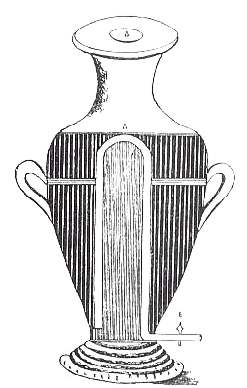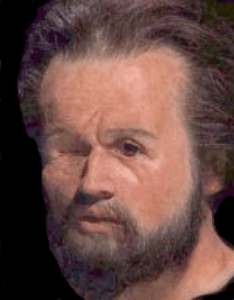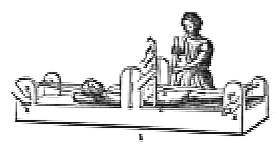.
Medizinische Erfindungen im antiken Griechenland
Herophilos (or Herophilus) of Chalcedon (about 280 BC) is said to have constructed a portable waterclock used to measure the pulse of patients.

The waterclock of Herophilos (Mitteilung zur Geschichte der Medizin)
Syringe
Syringe (Greek “pyulkos”, Latin “pyulcus”, i.e. “pus puller”) first description by Hero of Alexandra. The cylinder-and-pistol syringe was created about 280 BC by Ctesibius. Used to drain pus out of pimples, boils, and infected wounds.
The Spoon of Diokles (Diocleus cyathiscus) (κυαθίσκος του Διοκλέους )

Bernd Karger, Hubert Sudhues, Bernd Brinkmann, Arrow Wounds: Major Stimulus in the History of Surgery, World Journal of Surgery 25, Number 12 2001 , 1550 - 1555, Springer (PDF File for subscribers)
Diokles (or Diocles) of Carystos (Διοκλής ο Καρύστιος) ( fl. 360-330 BC)

Reconstruction of Philip II, the father of Alexander the Great, from the skull found by Manolis Andronikos. Philip II lost his right eye hit by an arrow during a battle (18 years later he was killed at the wedding of his daughter Cleopatra).
According to Pliny the Elder Philip’s surgeon Kritoboulos, prevented the serious disfiguring of the king’s face after Philip of Macedon lost his eye in the Siege of Methone. He used a specialized surgical instrument for removal of arrows, known as “the spoon of Diokles” after its inventor Diokles of Karystos, a student of Aristotle.
Arrow-Wounds.--According to Otis the illustrious Baron Percy was wont to declare that military surgery had its origin in the treatment of wounds inflicted by darts and arrows; he used to quote Book XI of the Iliad in behalf of his belief, and to cite the cases of the patients of Chiron and Machaon, Menelaus and Philoctetes, and Eurypiles, treated by Patroclus; he was even tempted to believe with Sextus that the name iatros, medicus, was derived from ios, which in the older times signified "sagitta," and that the earliest function of our professional ancestors was the extraction of arrows and darts. An instrument called beluleum was invented during the long Peloponnesian War, over four hundred years before the Christian era. It was a rude extracting-forceps, and was used by Hippocrates in the many campaigns in which he served. His immediate successor, Diocles, invented a complicated instrument for extracting foreign bodies, called graphiscos, which consisted of a canula with hooks. Otis states that it was not until the wars of Augustus that Heras of Cappadocia designed the famous duck-bill forceps which, with every conceivable modification, has continued in use until our time. Celsus instructs that in extracting arrow-heads the entrance-wound should be dilated, the barb of the arrow-head crushed by strong pliers, or protected between the edges of a split reed, and thus withdrawn without laceration of the soft parts. According to the same authority, Paulus Aegineta also treated fully of wounds by arrow-heads, and described a method used in his time to remove firmly-impacted arrows. Albucasius and others of the Arabian school did little or nothing toward aiding our knowledge of the means of extracting foreign bodies. After the fourteenth century the attention of surgeons was directed to wounds from projectiles impelled by gunpowder. In the sixteenth century arrows were still considerably used in warfare, and we find Pare a delineating the treatment of this class of injuries with the sovereign good sense that characterized his writings. As the use of firearms became prevalent the literature of wounds from arrows became meager, and the report of an instance in the present day is very rare.
Anomalies and Curiosities of Medicine by George M. Gould and Walter L. Pyle
Hippocratic Bench


Hippocratic treatment of spine injuries—the rack system and the technique of using gravity to straighten the spine. From Hippocrates: The Genuine Works of Hippocrates (translated by Adams F). London: Sydenham Society, 1844, Vol 2.
The so-called Hippocratic bench or scamnum was converted from a healing device later into a torture device, the rack. (On Joints)
Hippocrates writes in “On the Articulations”:
There are many varieties of curvature of the spine even in persons who are in good health; for it takes place from natural conformation and from habit, and the spine is liable to be bent from old age, and from pains. Gibbosities (or projections backward) from falls generally take place when one pitches on the nates, or falls on the shoulders. In this case some one of the vertebrae must necessarily appear higher than natural, and those on either side to a less degree; but yet no one generally has started out of the line of the others, but every one has yielded a little, so that a considerable extent of them is curved. On this account the spinal marrow easily bears such distortions, because they are of a circular shape, and not angular. The apparatus for the reduction in this case must be managed in the following manner: a strong and broad board, having an oblong furrow in it, is to be fastened in the ground, or, in place of the board, we may scoop out an oblong furrow in the wall, about a cubit above the floor, or at any suitable height, and then something like an oaken bench, of a quadrangular shape, is to be laid along (the wall?) at a distance from the wall, which will admit of persons to pass round if necessary, and the bench is to be covered with robes, or anything else which is soft, but does not yield much; and the patient is to be stoved with vapor, if necessary, or bathed with much hot water, and then he is to be stretched along the board on his face, with his arms laid along and bound to his body; the middle, then, of a thong which is soft, sufficiently broad and long, and composed of two cross straps of leather, is to be twice carried along the middle of the patient's breast, as near the armpits as possible, then what is over of the thongs at the armpits is to be carried round the shoulders, and afterward the ends of the thong are to be fastened to a piece of wood resembling a pestle; they are to be adapted to the length of the bench laid below the patient, and so that the pestle-like piece of wood resting against this bench may make extension. Another such band is to be applied above the knees and the ankles, and the ends of the thongs fastened to a similar piece of wood; and another thong, broad, soft, and strong, in the form of a swathe, having breadth and length sufficient, is to be bound tightly round the loins, as near the hips as possible; and then what remains of this swathelike thong, with the ends of the thongs, must be fastened to the piece of wood placed at the patient's feet, and extension in this fashion is to be made upward and downward, equally and at the same time, in a straight line. For extension thus made could do no harm, if properly performed, unless one sought to do mischief purposely. But the physicians, or some person who is strong, and not uninstructed, should apply the palm of one hand to the hump, and then, having laid the other hand upon the former, he should make pressure, attending whether this force should be applied directly downward, or toward the head, or toward the hips. This method of applying force is particularly safe; and it is also safe for a person to sit upon the hump while extension is made, and raising himself up, to let himself fall again upon the patient. And there is nothing to prevent a person from placing a foot on the hump, and supporting his weight on it, and making gentle pressure; one of the men who is practiced in the palestra would be a proper person for doing this in a suitable manner. But the most powerful of the mechanical means is this: if the hole in the wall, or in the piece of wood fastened into the ground, be made as much below the man's back as may be judged proper, and if a board, made of limetree, or any other wood, and not too narrow, be put into the hole, then a rag, folded several times or a small leather cushion, should be laid on the hump; nothing large, however, should be laid on the back, but just as much as may prevent the board from giving unnecessary pain by its hardness; but the hump should be as much as possible on a line with the hole made in the wall, so that the board introduced into it may make pressure more especially at that especially at that spot. When matters are thus adjusted, one person, or two if necessary, must press down the end of the board, whilst others at the same time make extension and counter-extension as along the body, as formerly described. Extension may also be made with axles, which may either be fastened in the ground beside the bench, or the post of the axles may be attached to the bench itself, if you will make them perpendicular and overtopping (the bench?) a little at both ends, or at either end of the bench. These powers are easily regulated, so as to be made stronger or weaker, and they are of such force, that if one were to have recourse to them for a mischievous purpose, and not as a remedy, they would operate strongly in this way also; for by making merely extension and counter-extension longitudinally, without any additional force, one might make sufficient extension; and if, without making extension at all, one were only to press down properly with the board, sufficient force might be applied in this way. Such powers, then, are excellent which admit of being so regulated, that they can be made weaker and stronger as required. And the forces are applied in the natural way; for the pressure above forces the displaced parts into their place ...
Tampons
The ancient Egyptians invented the first disposable tampons made from softened papyrus.The ancient Greeks invented tampons made from lint wrapped around a small piece of wood, recorded in the writing by Hippocrates in the fifth century B.C. ...In 1929, the modern tampon (with applicator) was first invented and patented by Doctor Earle Haas who wanted to invent a tampon that could be effectively mass produced. Earle Hass filed for his first tampon patent on November 19, 1931. His patent description was for a "catamenial device," derived from the Greek word for monthly. He later tradmarked Tampax as the brandname for his tampon product. From http://www.learnlink.emory.edu/~ablankn/
Links
A Display of Surgical Instruments from Antiquity
Roman Surgical Instruments
The doctor's grave at the Stanway site
Search: Bibliography Medical Instruments in Antiquity
References
John Stewart Milne Surgical Instruments in Greek and Roman Times. Claredon Press: Oxford, 1907
Celsus’ de Medicina is essentially a Latin translation of a Greek text by Aufidius, a Sicilian; Farrington 1949 p. 127.
| Ancient Greece
Science, Technology , Medicine , Warfare, , Biographies , Life , Cities/Places/Maps , Arts , Literature , Philosophy ,Olympics, Mythology , History , Images Medieval Greece / Byzantine Empire Science, Technology, Arts, , Warfare , Literature, Biographies, Icons, History Modern Greece Cities, Islands, Regions, Fauna/Flora ,Biographies , History , Warfare, Science/Technology, Literature, Music , Arts , Film/Actors , Sport , Fashion --- |

